Epidotes (silicates): Dioptase
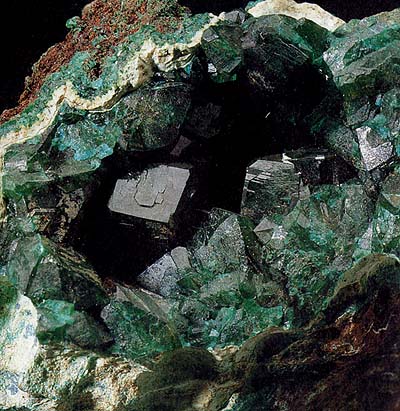 Diagnostic card.
Diagnostic card.
On the picture. The lemonite lemonite lined with dioptase.
Cu 6 Si 6 O 18 * 6 (H 2 O)
The trigonial trigonometric system
Hardness
Specific weight 3,3
Cleavage is perfect
Cracked shell
Color thick green
Color in powder green
Glitter glass
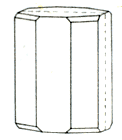
It is dyed green, almost black, with a noticeable light blue tinge. Color is more characteristic for little transparent and even completely opaque crystals. They have a short-columned prismatic appearance and are marked by light hatching on the faces. Dioptase rarely forms individual crystals; for it, clusters of crystals, sometimes quite large in size, lining the walls of voids in the parent rock and forming brushes are more characteristic. The glitter is glassy, but on the cleavage planes it can be pearly. Although dioptase is attractive due to its excellent coloring and glossing on facets of faceted stone, it is not used very much because of its high hardness and easy cleavage cleavage.
Dioptase is a rare mineral. Its crystals are short-prismatic pointed, more rarely - rhombohedral. It occurs when weathering copper deposits and is usually found in areas with a hot arid climate. Deposits of dioptases are discovered in Kazakhstan, USA (Arizona) and Chile. In Africa, dioltases are mined in Zaire, Namibia and Congo. It is no accident that one more outdated name for these minerals is the Congolese emerald.
Chemical composition. Copper oxide (CuO) 50.5%, silica (SiO2) 38.1%, water (H2O) 11.4%. The shape of the crystals. Rhombohedrons, small prisms. Crystal structure. Anionic complexes consisting of six-membered rings with the formula [Si6O18] 12 - and water molecules in the channels of these rings. Class of symmetry. Rhombohedral. Cleavage. Perfect for the rhombohedron (1010). Aggregates. For the most part, individual crystals.
Dioptaz in the old days was called a copper emerald for its similarity to emeralds real. Therefore, dioptae is sometimes called the "younger brother" of the emerald. Crystals of dioptase, usually not exceeding 1-3 cm and often forming beautiful druses in nature, were often used to simulate precious emeralds. Transparent emerald-green crystals of the mineral were first taken for emeralds: small prisms shone in the sun and glowing green gleamed through the bright green of their faces. However, further study of the find showed that the first impression is deceptive: the composition of the mineral, and its low hardness, and perfect cleavage convinced scientists that the stone has nothing to do with this emerald.
Diagnostic signs.
Refractory, amenable to the action of ammonia and acids. Does not melt, with soda gives a copper crown. Behavior in acids. It decomposes in HCl and HNO3 with liberation of the silica gel.
Origin.
Dioptase is a very rare mineral formed in the oxidation zone of copper ore deposits, where it is associated with chrysocolla.
Deposits and applications.
The most famous location is Altyn-Tube Mountain in Kazakhstan, where copies of outstanding transparency are found. Other notable deposits are Mindouli (People's Republic of the Congo) and Tsumeb (Namibia). Dioptase is obtained in Copiapo (Chile), Atacama (Argentina), Batia (Romania), Arizona (USA), various places in Peru. Dioptase is used to make art products. Deposits of dioptases are discovered in Kazakhstan, USA (Arizona) and Chile. In Africa, dioltases are mined in Zaire, Namibia and Congo. It is no accident that one more outdated name for these minerals is the Congolese emerald.
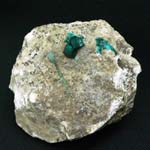
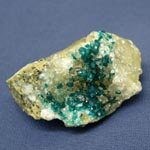
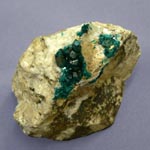
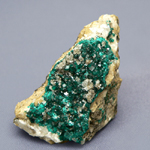
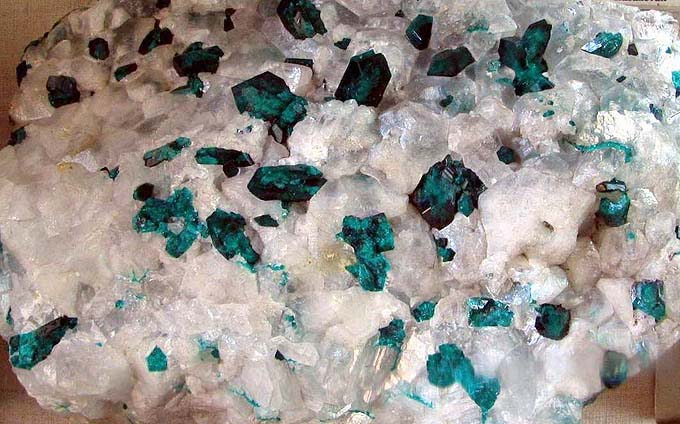
Dioptase (crystals up to 2 cm) in calcite. Gushab, Namibia. Photo: © А.А. Evseev.
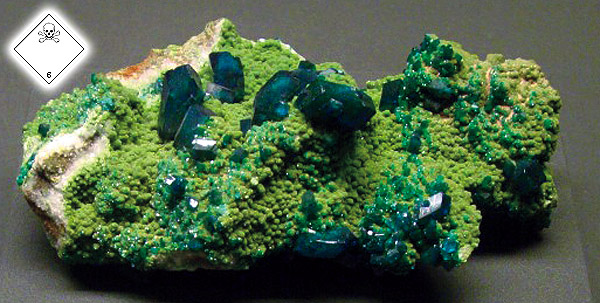
Dioptase, cochialcite (druza small green crystals). Namibia.
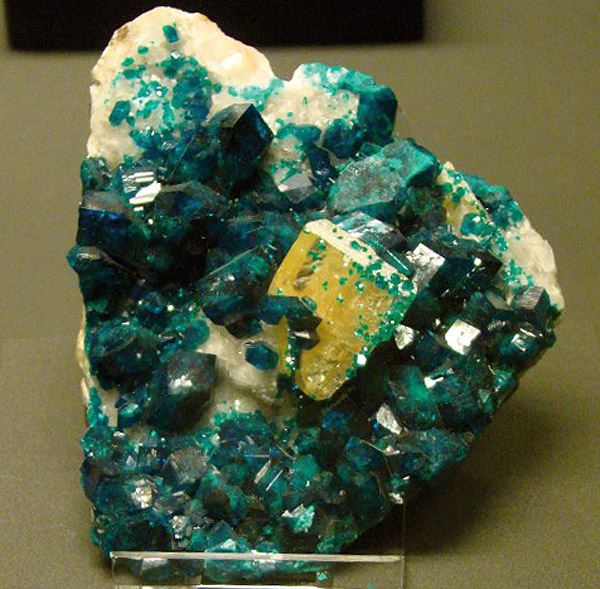
Vulfenit (yellow), dioptase (green). Namibia.
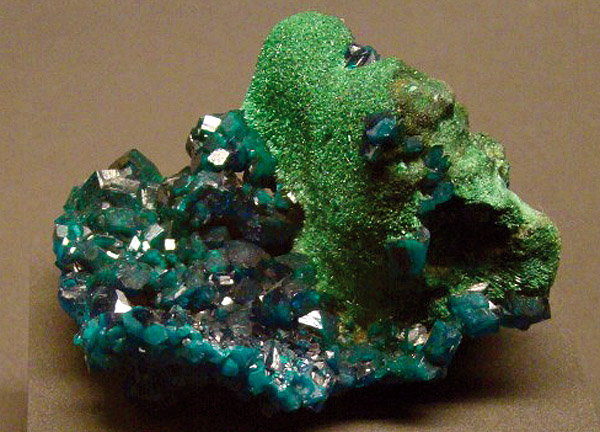
Dioptase, malachite (green, top right druses). Namibia.
- Ghetchellit - "New Almaden blend" - arsenide and antimony sulfide (modern sulfosol)
- Antimony is a toxic metal (semimetal) , widely used in metallurgy, medicine and engineering
- Zirconium - a rare and undiscovered metal and the most dangerous precious stone in oxide and salt
- Gold - yellow dangerous and poisonous metal of modern accurate digital and cable technologies
- Sulfur is a golden-yellow toxic substance and a sign of active volcanic activity
- Cadmium is an undisputed toxic silvery metal unknown to a wide range of people
- Lead - a toxic gray imitator of metallic silver and toxic metal blende
- Arsenic is a classic poison of medieval and modern poisoners and medicine in medicine
Poisonous and radioactive dangerous stones and minerals
** - poisonous stones and minerals (mandatory check in the chemical laboratory + explicit indication of toxicity)
** - radioactive stones and minerals (mandatory check on the standard dosimeter + ban on open sales in case of radioactivity exceeding 24 milli / g / h + additional measures of population protection)
Catalog of minerals and semi-precious stones of the world by groups
** - poisonous stones and minerals
** - radioactive stones and minerals


Comments
When commenting on, remember that the content and tone of your message can hurt the feelings of real people, show respect and tolerance to your interlocutors even if you do not share their opinion, your behavior in the conditions of freedom of expression and anonymity provided by the Internet, changes Not only virtual, but also the real world. All comments are hidden from the index, spam is controlled.